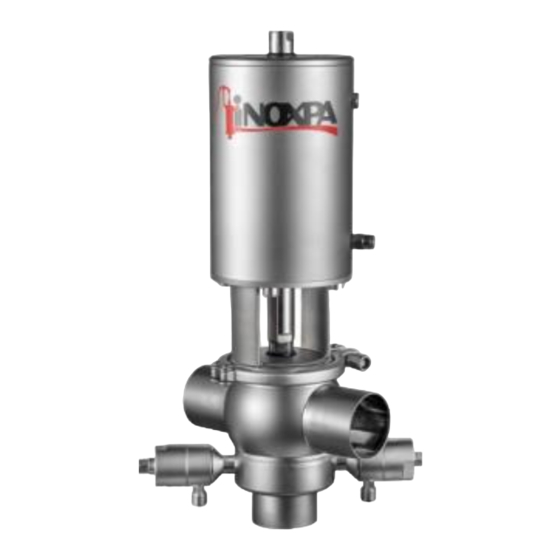
INOXPA INNOVA D Installation, Service And Maintenance Instructions
Hide thumbs
Also See for INNOVA D:
Table of Contents
Advertisement
Quick Links
ANNEX FOR CE MARKED EQUIPMENT ACCORDING TO THE
INNOVA D Ex DOUBLE SEAL MixProof VALVE
The content of this Annex supplements the information in the instruction
manual. The instructions in this Annex must be taken into account in
conjunction with the equipment marked according to Directive
2014/34/EU.
This Annex is complemented, if applicable, by the manuals of the
ATEX-certified components comprising the assembly.
INSTALLATION, SERVICE AND
MAINTENANCE INSTRUCTIONS
ATEX DIRECTIVE 2014/34/EU:
1
Original Manual
10.246.30.07EN
(0) 2022/11
Advertisement
Table of Contents

Summary of Contents for INOXPA INNOVA D
- Page 1 ANNEX FOR CE MARKED EQUIPMENT ACCORDING TO THE ATEX DIRECTIVE 2014/34/EU: INNOVA D Ex DOUBLE SEAL MixProof VALVE The content of this Annex supplements the information in the instruction manual. The instructions in this Annex must be taken into account in conjunction with the equipment marked according to Directive 2014/34/EU.
- Page 2 Telers, 60 17820 – Banyoles (Girona) Hereby declare under our sole responsibility that the machine DOUBLE SEAL MIX PROOF VALVE Model INNOVA D From serial number IXXXXXXXXX IXXXXXXXXX Fulfills all the relevant provisions of Safety and Health from ATEX 2014/34/EU Directive...
-
Page 3: Safety
The valve was selected according to the working conditions specified by the user, therefore INOXPA is not responsible for any damage that may occur due to the use of valve under conditions other than those stated in the order If the valve is used for inflammable liquids, it must be observed that every operating process is combined with an operating leakage. - Page 4 1.4.4. Compliance with the instructions Failure to comply with the instructions may prove hazardous for operators, the environment, the machine and the installations, leading to a loss of rights for claiming damages. This non-compliance may result in the following hazards (in addition to those already listed in the manual): - Generation of explosive atmospheres and risk of explosion.
-
Page 5: Table Of Contents
7. Maintenance 7.1. General information 7.2. Maintenance 7.3. Cleaning 7.4. Assembly and disassembly 7.5. Disassembly / Assembly of the INNOVA D valve 7.6. Replacing the seat seal 7.7. Actuator assembly / disassembly 7.8. Disassembly/Assembly of the leak detector 8. Technical specifications 8.1. -
Page 6: Installation
4. Installation 4.1. DELIVERY OF THE VALVE It should be checked that the valve received is adjusted to the working conditions in the classified zone as well as the order conditions 4.3. IDENTIFICATION ATEX valves should be identified in a complementary manner: II 2G Ex h IIB T6…T3 Gb II 2D Ex h IIIB T85ºC…T200 C Db... -
Page 7: Start-Up
The valve was selected for certain working conditions in potentially explosive atmospheres at the time of placing the order. INOXPA is not liable for any damage that may arise if the information provided by the buyer is incomplete or incorrect (liquid type, viscosity, classification of the potentially explosive area, gas generated by the potentially explosive atmosphere, etc.) -
Page 8: Maintenance
If the spare parts are not requested in this way, INOXPA shall not be responsible for the case that the valve may not operate with parts which are not suitable for the classified zone where is installed. -
Page 9: Disassembly/Assembly Of The Leak Detector
7.5.1. Disassembly: 1. Apply compressed air to the actuator so that the plug stem (08) is in the open position (only for NC valves). 2. Loosen and separate the clamp (34). 3. Separate the actuator (10) from the valve body (01). 4. -
Page 10: Technical Specifications
8. Technical Specifications Temperature range. See section 4.3. PNEUMATIC ACTUATOR GENERAL DATA The pneumatic actuator cannot exceed, under any circumstances, the 12 cycles per minute to ensure that there is no significant increase in temperature. In any case, in ongoing work it is not recommended to exceed the 2/3 cycles per minute to ensure a reasonable life of the seal.












Need help?
Do you have a question about the INNOVA D and is the answer not in the manual?
Questions and answers